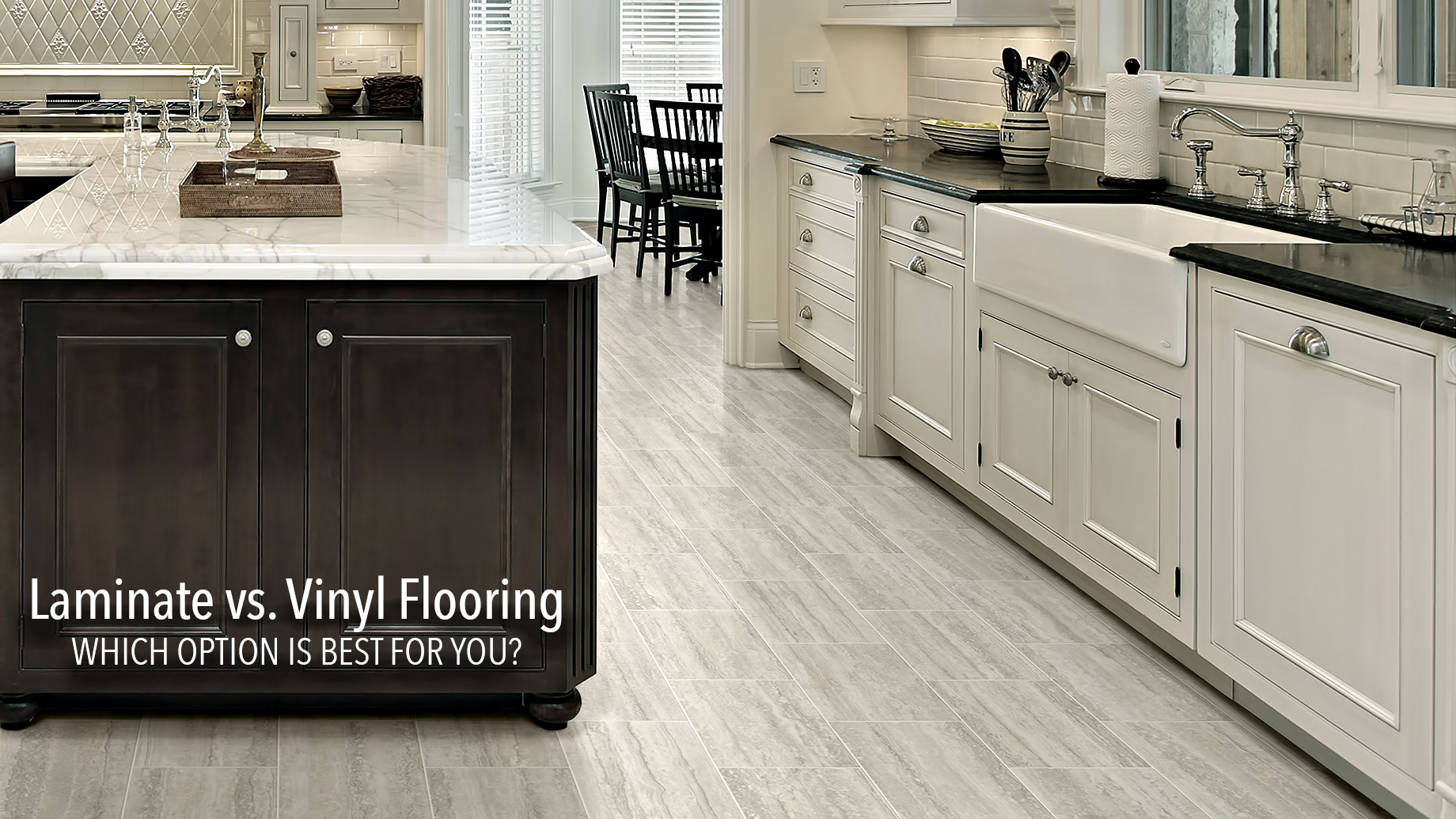
To many people, laminate and vinyl are two sides of the same coin. But the two flooring options couldn’t be more different.
Both come with flexible self-installation options, but that’s about where the similarities end. Check out this guide on how to choose between laminate versus vinyl flooring.
What is the Difference Between Vinyl and Laminate Flooring?
The biggest difference between vinyl and laminate flooring is the ingredients. Vinyl is always made from plastic, whereas laminate is mostly wood-based.
When you choose sheet vinyl and vinyl tiles, the bottom layer is typically made of fiberglass and then coated in PVC vinyl. On top of that, a plasticizer is added, followed by the top layer that includes a printed design. Vinyl flooring comes with a thick coating of no-wax polyurethane, making it resistant to moisture. The core layer of vinyl flooring is thicker than laminate, but the overall thickness of a sheet only ranges from 1.5mm to 5mm.
Laminate can look a lot like vinyl floors and is often installed in the same way. But laminate floors are mostly made from wood byproducts and then sealed with a plastic layer on top. The surface of laminate floors is thick and transparent, covering the design of the flooring. The overall thickness of the laminate is much larger than vinyl ranging from 6mm to 12mm. Much of this thickness is in the top layer and not the core of the flooring product. Because laminate is made mostly of wood, it’s not going to stand up to high moisture environments like vinyl. This makes laminate far more limited in its use around the home than vinyl flooring. However, laminate floorings have their own aesthetic appeal, which makes them stand out. For example, black laminate flooring is preferred by many people because of its stunning looks.
Where to Use Laminate vs. Vinyl Flooring
No matter whether you choose laminate versus vinyl flooring, the cost is an investment into the improvement value of your home. Think carefully about where you want to install the flooring before making a financial commitment.
When you sell your home, the look and feel can make or break a buyer’s impression. Use flooring that will hold up well in the spaces where it’s used.
Kitchens
Using vinyl flooring in a kitchen is a no-brainer. While it’s great to use natural materials when you can, it’s more important to have surfaces that are durable and moisture resistant. Spilled spaghetti sauce, red wine, or other dark liquids can cause staining on natural floors like laminate. You won’t have to worry about any spills with vinyl floors.
The other reason to choose vinyl over laminate is it’s easier to stand on for long periods of time. Laminate floors tend to mimic wood which is a very hard surface compared to vinyl. When cooking for hours during the holidays, you’ll want a softer surface to stand on. Also, if a dish drops, it’s less likely to shatter on contact when you have a vinyl floor.
Vinyl comes in a variety of styles that look like tile, stone, or hardwood, so you don’t have to sacrifice the design style of the room. A luxury vinyl plank gives a room a high-end look at a fraction of the cost.
Bathrooms
Most people think of tile or stone when thinking of bathroom flooring. While these are both great, durable flooring options, vinyl offers a much wider range of styles at a lower cost.
Vinyl brings instant warmth to your flooring, unlike tile or laminate floors. Laminate is a poor choice for bathrooms because the planks will eventually buckle, causing permanent damage.
Orient your luxury vinyl tiles in artistic patterns to match intricate tile designs if you want a unique look. There are a few limits to the themes you can incorporate into your bathroom with vinyl flooring.
Living Room
Choose laminate flooring in formal living rooms to bring an elegant, timeless style. Because laminate resembles hardwood, your living room will look instantly upgraded.
Laminate is hard and durable, making it a good choice for high-traffic areas like your foyer. This is a major bonus because it means you won’t need two separate flooring materials if both rooms are connected.
Bedroom
Combined with an area rug, a laminate floor is also a great choice for a bedroom. Use an underlay to soften your step on the floor and make the flooring much quieter to walk on.
Laminate floors in dark wood styles can make a bedroom with high ceilings feel cozier. In guest bedrooms, opt for more trendy styles like designs that look like tile.
Dining Rooms
Near-white laminate floors are the perfect way to brighten a modern dining room. The neutral laminate floor blends the point where walls and floors connect, making a striking visual impact.
This durable flooring choice can also create a more classic style in your dining room with medium brown wood-like tiles. You’ll have an easy time matching your existing furniture without the need to redesign the entire room.
Laminate is a better choice than vinyl in dining rooms because it’s much more formal. The softness of vinyl brings a casual feel to a room.
What Flooring Type is Best?
Choosing laminate versus vinyl flooring is no easy decision. Unless you’re designing a high moisture room, both options could work well and are budget-friendly.
Let your final design come down to available style options within your price range. You should also consider which styles look best with your existing furniture.
Neutral color choices give you the most flexibility, even if they lack visual interest. For more information and tips for your home, visit our blog for updates.